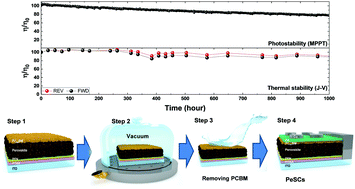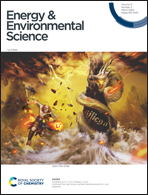Highly stable inverted methylammonium lead tri-iodide perovskite solar cells achieved by surface re-crystallization†
Abstract
Despite the promise of simple manufacturing via an entirely solution-based process at low temperature (<100 °C), the planar-type inverted perovskite solar cells (PeSCs) based on methylammonium lead tri-iodide (MAPbI3) still suffer from a notorious instability problem under operational conditions. Here, we found that the operational stability of PeSCs with MAPbI3 is significantly related to a high density of ionic defects and correlated amorphous regions at the interface between the electron transport layer and the MAPbI3 film. By recrystallizing the surface of the MAPbI3 layer, we fabricate defect-free stoichiometric MAPbI3 crystals and demonstrated burn-in loss-free and intrinsically stable inverted MAPbI3 PeSCs. The inverted MAPbI3 PeSCs exhibited a power conversion efficiency (PCE) of 18.8% and maintained over 80% and 90% of their initial PCEs even after 1000 hours of real operation (under AM 1.5G irradiation) and continuous heating conditions (at 85 °C in the dark), respectively. Our work demonstrates that the MAPbI3 layer under ionic defect-free conditions is ‘intrinsically’ stable under operational conditions.



 Please wait while we load your content...
Please wait while we load your content...